Group 156A
Design Thinking
Module 3
Empathy
Our empathy evolved multiple times over the course of the module. Originally, our empathy dealt with us, college students. We first wrote down everything that we had with us at most times of the day and tried to come up with solutions of combining these various things. The issue of scattered materials, papers ending up in the wrong folders, having to carry a back pack and a computer bag, etc. We scratched that idea. Then, still involving college students, we turned our focus to their messy note taking in class. We found a problem to be the difficulty of effective note taking in class and then the constant struggle to understand their notes when looking back at them.
After talking with a professor, our empathy evolved into issues with noise and the effects of noise with college students. Our empathy stemmed from the basic fact of noise pollution. A problem arose when we came to realize that whenever you go somewhere, whether it be in the city or even an apartment complex, there is always background noise that doesn't allow you to focus or becomes distracting. Our original idea involved empathizing with the college student who lives in a dorm room. The reason for this being is quite simple because there is noise happening at all hours of the day in residence halls. Deriving from this problem, we wanted our solution to be a way to cancel outside noise and to focus on the sounds that you want to hear. For example, we wanted to form a solution so a dorm mate could watch television without disturbing a sleeping roommate, or have an alarm go off for an early class without waking up a roommate who does not have an early morning class, and vise versa so you will not be disturbed by others, unwanted noise.
Our second empathy came about during our last face to face with the professors which took place on Tuesday. We were introduced to an issue which we had not taken into account; real world uses; luxury vs. necessity; and gaining a solution from problems dealing with security, education, and natural disasters. We took our empathy involving noise and ran with it. We came up with ideas like adding something onto helicopter for more effective communication during search and rescue, communication to guide the blind, emergency sirens, and in a noisy classroom setting, canceling constant noise pollution for better hearing of a topic or instruction. With much evolution, our final empathy finally formed to solve noise issues that hinder communication in loud, collaborative classroom environments.
Define
After the long, arduous task of finding a way to successfully empathize a solution with a group, we came to the rather demanding task of redefining our point of view statement. Originally we wanted to solve noise issues within high density residences such as dorms or apartments while still allowing people to enjoy their audio sources at high volumes. After much evaluation, ideating and a discussion of this idea with the professors, we came up with a more need based problem. Eventually we decided to solve problems of noise levels that hinder communication and cause distraction in the classroom, more specifically, group and collaborative work in the classrooms of all levels, not just college.
POV Statement:
Collaborative classroom settings need a better solution for enhancing intra-group communication and limiting or eliminating inter-group distractions.

Ideation
The process of ideation started under a different direction than our final design. It began as a device that would allow you to listen to audio without disturbing others. Our ideas for this included a malleable portable speaker that you can take anywhere and form however you want as a way of directing the sound. Another idea was in combination with a bed and not portable. it canceled sound more than it produced directional sound. Our final idea under this direction was more of a center piece either in the form of an orb or a lamp type shape that projected directional sound and had some form of motion tracking so that even if you moved around you were the only one in the room that heard what it was playing.
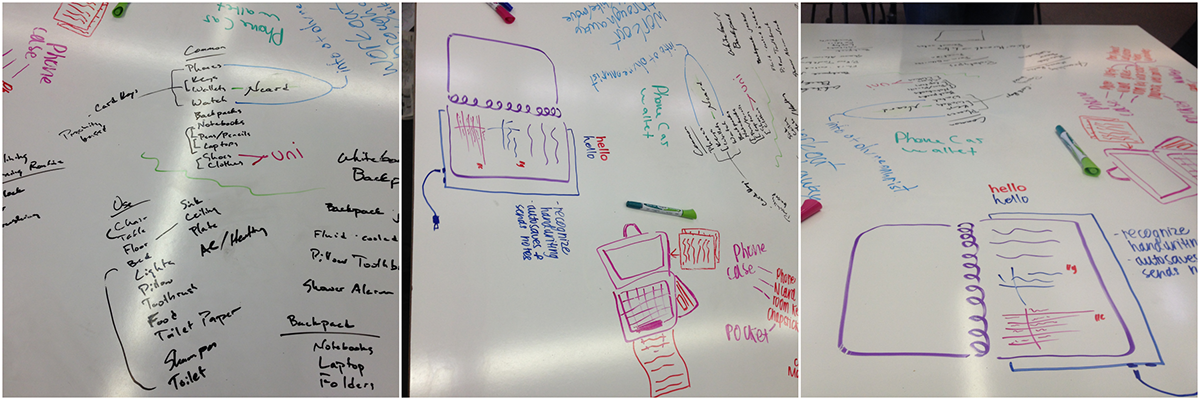

At this point we changed to a more need based problem and began designing for the classroom
setting. We thought about permanent ceiling installations, or embedding into desks, but upon evaluation
of the options, the centerpiece idea from before seemed to be the best because of it's ability to be
flexible in its deployment.
Once we settled on the centerpiece idea we started to think about the form it should take. We came
up with shapes ranging from odd looking cones, to hemispheric orbs, to more cubic designs. After
evaluating performance and function criteria (see test) we decided on the trapezoidal form below.
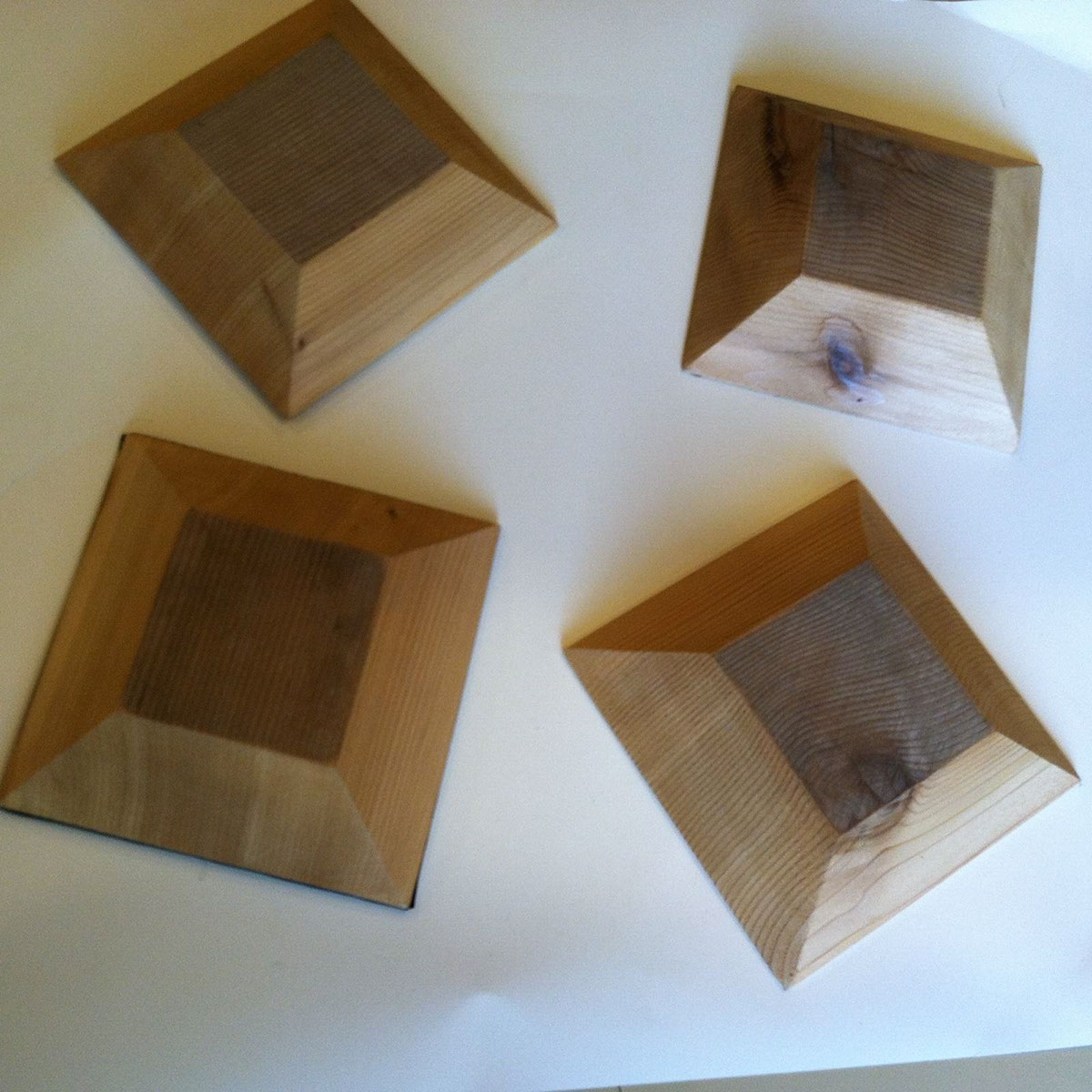
We also did some research into the technology that would make our ideas work. The technologies
that fit the bill were hypersonic sound and active noise cancelation. These were technologies we had
begun researching early on and were able to apply to our design after we changed focus to a more need
based problem. Here are the technologies explained.
After developing an understanding of the technology at play, we were able to ideate more into the
things it would be capable of doing. We came up with a system where each module is dependent on the
others. When a teacher deploys them on each desk, they all communicate with each other via some
short range data field, we had bluetooth in mind. They communicate where they are at in relation to one
another and develop individual zones that each are responsible for canceling noise in. From there the
module at group A's table picks up the voices from group A first and tells the modules for groups B and
C to cancel out that noise. In this way they cancel out noises from other groups, but don't cancel noises
from their own respective group, keeping communication within group clear while doing away with
noises from other groups.
Prototype & Test
Our early physical prototypes tested geometries that would be flexible for a luxury speaker. The one testing hexagons was really nice because it could be physically held, bent, and twisted to see exactly how well hexagons could flex, which wasn't quite as good as we'd hoped. The other early geometry prototype was nice because it allowed us to test different shapes and how they folded up. The shapes we had in mind did not fold nicely. This was an ever changing prototype because we cut different shapes out of the cardboard to see how they would fold with one another. This changeable prototype allowed us to test multiple shapes until we found one that would work. Drawings were also important early on in determining the form. One of our drawings took 3D form when it was drawn on a balloon and gave us a better idea of the scale.

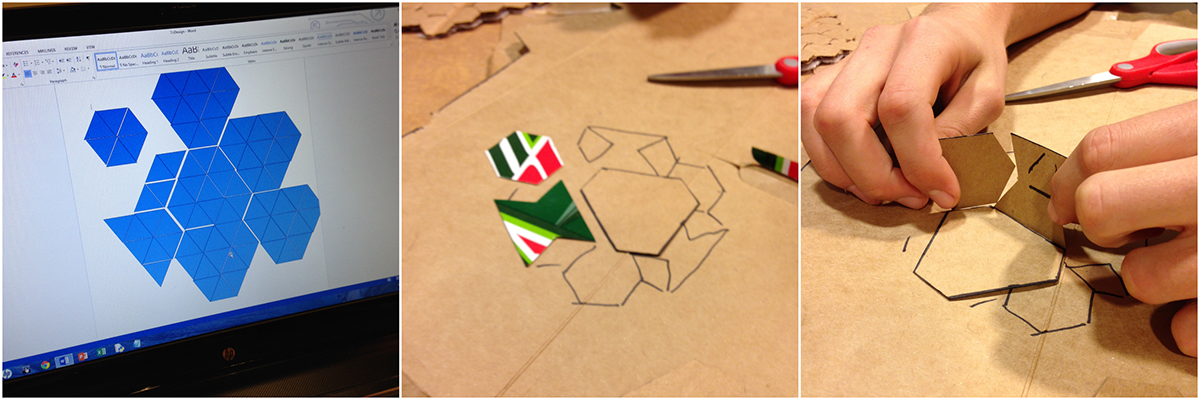
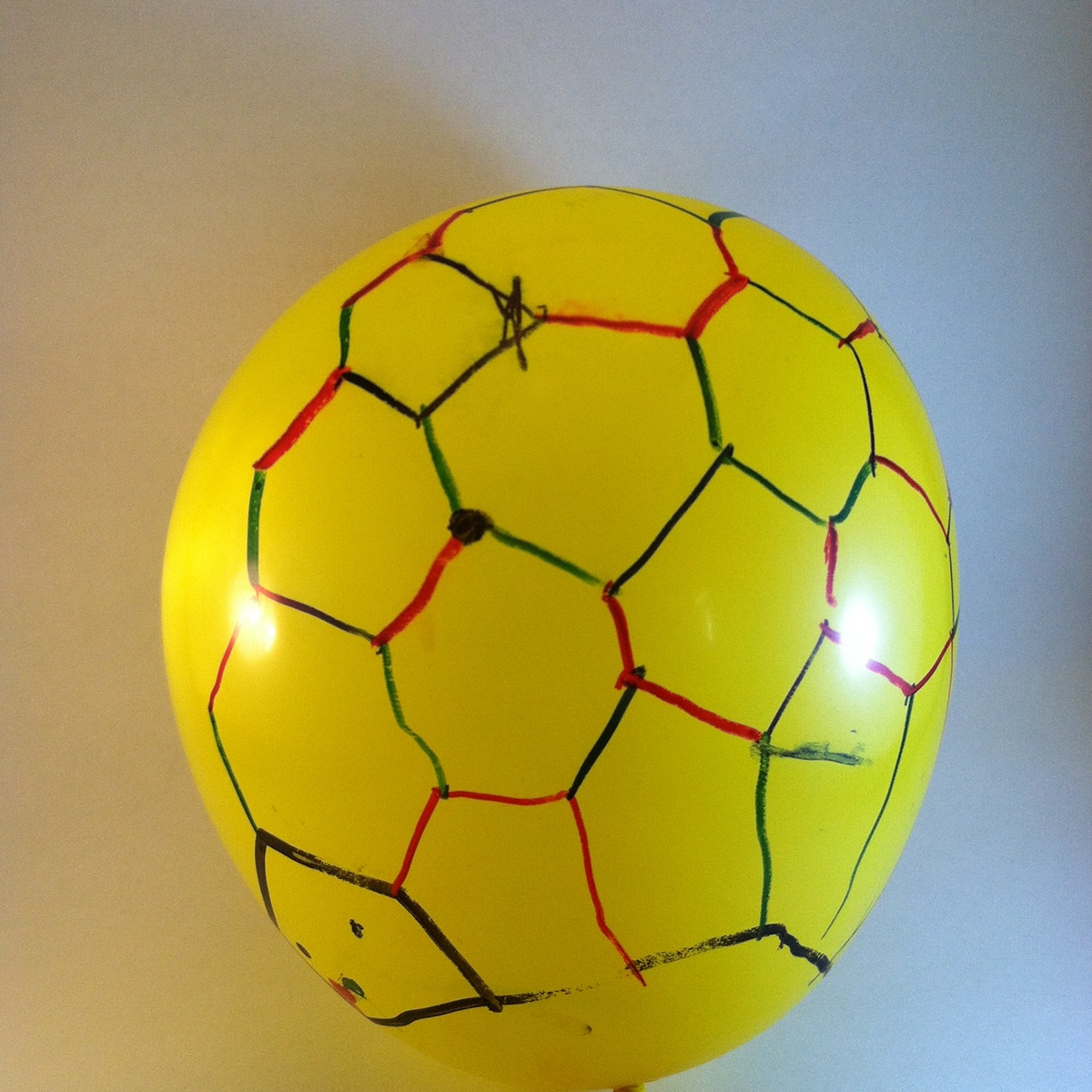
One of the tests we applied in our design was an evaluative one. Once we turned to a need based
classroom problem we evaluated the current solutions to noise control looking at the pros and cons of
each. The current solutions we identified included: mobile or permanent walls, talking louder, not talking,
noise canceling headphones, wall mounted sound absorbent materials, and white noise. Each item on
the list had qualities that were good and bad about them. Walls abolished inter-group distractions and
blocked noise well, but they limited visibility and therefore teachers' classroom control. Talking louder
gets your idea across, but if everyone does it, the noise level will become overbearing. Not talking
keeps that from happening, but then no collaboration can occur. Noise canceling headphones work very
well to cancel out sound even if they aren't playing any music, but the won't allow collaboration. Wall
mounted sound absorbents takes away reverb effects, but does nothing to diminish direct sound
sources. the pros and cons of white noise were less obvious and required further investigation. We had
heard the Assurity Life Insurance building utilized this technology in its office spaces. We contacted Bill
Shmeckly of Assurity Life Insurance and he explained that white noise is very effective in their office
space, but struggles to overcome anything louder than quiet phone calls and they must use separate
conference rooms for speaker phone or conference call uses. In sum we found out that white noise
begins to diminish sounds before the reverb process, but only works well at low volumes.
After identifying these pros and cons we outlined what the performance criteria for our design would
have to be. It would need to diminish sound like white noise, but do so as effectively as noise canceling
headphones (that use active noise cancelation), but not diminish sounds from within ones own group
almost creating virtual walls in space between groups. It couldn't block visibility like walls do, and we
wanted benefits of collaborative noises from other groups.


Once we had the checklist we used drawing prototypes as an integral part of ideation. We decided
individual tabletop modules would deploy easily and create the "virtual rooms" for each table group most
effectively. We drew many forms that the design could take very quickly and before long landed on the
shallow form seen below. We decided on this by taking into account what we needed the technology to
do according to our checklist and how effectively each of the forms we drew allowed them to do that.
The form we chose minimizes the number of separate direction speakers needed, lowering cost, yet still
allows 360 degrees of projection by adjusting angles of projection to 45 degrees. After deciding on the
form we referenced a working hypersonic speaker called the Soundlazer to decide what scale would
allow the hypersonic speaker to be large enough to be effective (seen in the drawing below).
This octagon form was the iteration prior to the square form above.
Once we had the prototype depicting the form, we sat it on the table during our group meetings. We
looked at how it sat on the table and were satisfied with its extreme stability, however, we did noticed
that it slid easily and decided to put a rubber base on it (black electrical tape). We also realized intensity
and range dials would have to be out of the way for students to tamper with so we put knobs only
adjustable with a screwdriver on the bottom. We also Thought about materiality of the frame and thought
it should be something that is resistant to being drawn on by doodling students and be very rigid and
strong. For this we had in mind aluminum like that used in mac products (we actually tested this material
by writing on a mac book, marks just rubbed off).
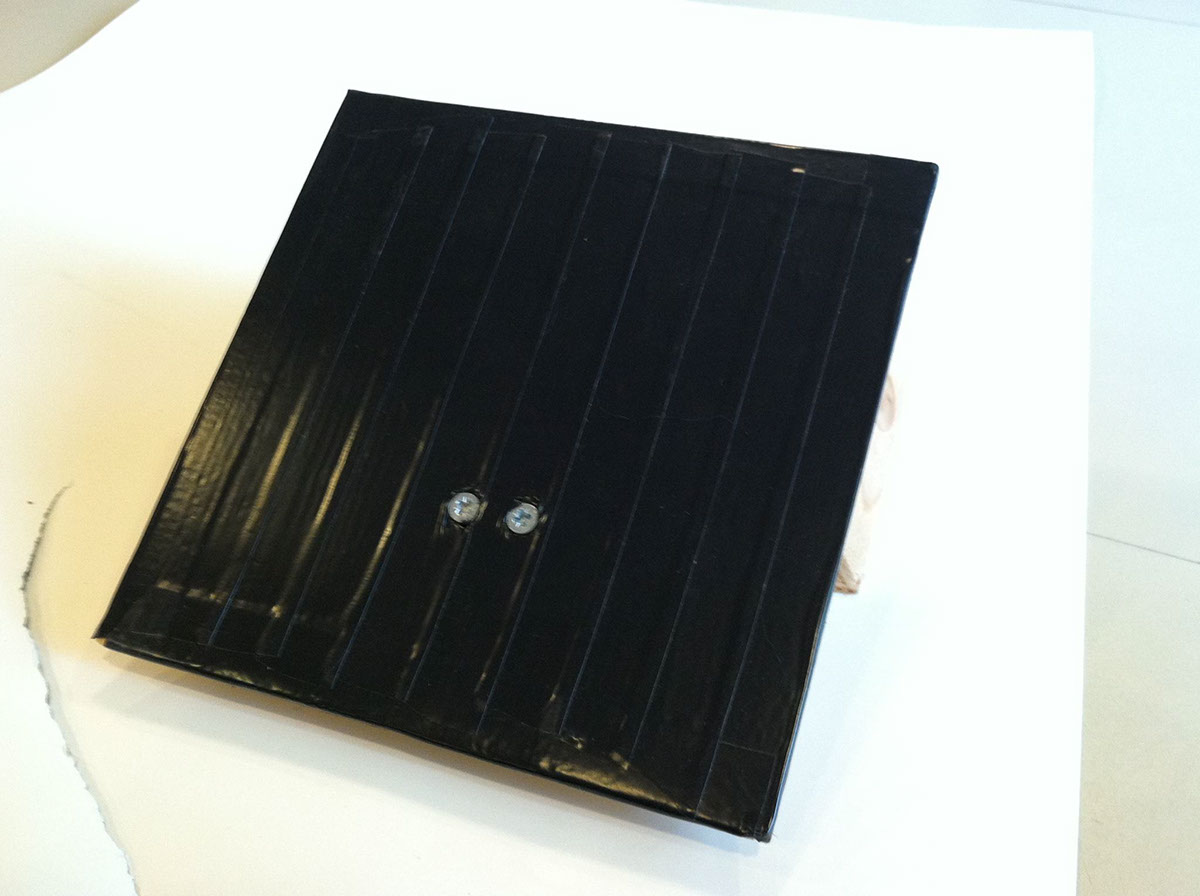
After placing one of the prototypes in the charging/storage dock we realized there should be multiple
charging strips (silver duct tape) so it wouldn't matter which way the module went in, it would always charge. The
design process continued until the last second and we decided each individual module would need an accessible
mute button on the top and that the charging/storage station would need a mute all button so instructors would
have more control and be able to make a class-wide announcement at the push of a button.
We also prototyped how they would work as a system by drawing diagrams. We drew circular zones that
each module would have an effective radius in, and where the circles overlapped we bisected it with a straight
line and that would become the boundary of each modules' range.They determine these boundary lines by
figuring out where they are in relation to one another using either hypersonic frequencies that humans couldn't
here or something else similar to wi-fi or bluetooth.

Collaboration
We developed a team contract on Google Drive and outlined several tasks we would each
accomplish. However, few of the tasks were completed solely by the person it was assigned to. Also,
many of the tasks we accomplished were done collaboratively as a group.

Critique
